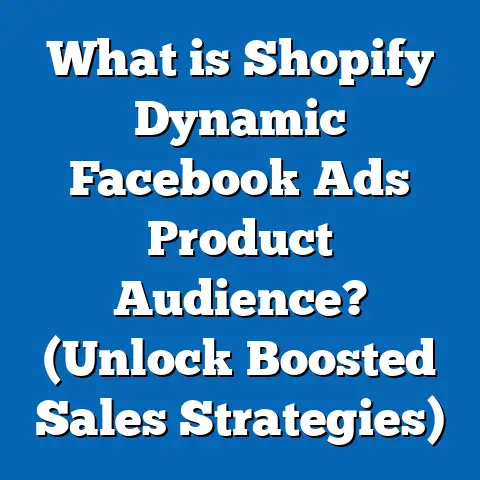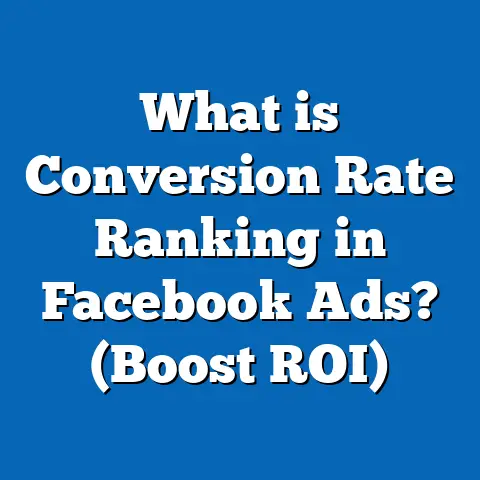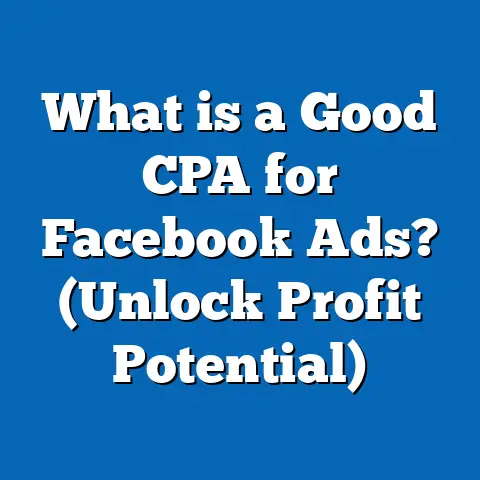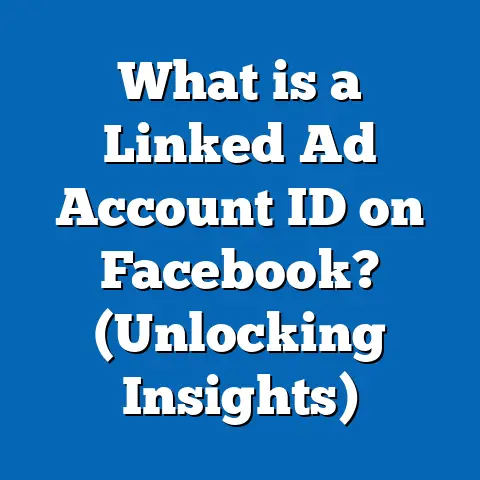What is Replacing Facebook Ads? (Emerging Trends Revealed)
Introduction: The Ease of Installation and the Shift in Digital Advertising
In the rapidly evolving digital marketing landscape, ease of installation and quick setup have become crucial factors for advertisers seeking to maximize their reach and return on investment. Facebook Ads, once the undisputed leader in online advertising due to their user-friendly interface and detailed targeting options, are now facing significant challenges. Changes in user privacy laws, shifts in consumer behavior, and the rise of new platforms have forced marketers to reconsider their advertising strategies.
Facebook’s platform was historically favored for its relatively straightforward setup process, enabling businesses of all sizes to launch campaigns swiftly and efficiently. However, recent developments—such as privacy updates from Apple and Google, rising advertising costs, and changes in Facebook’s algorithm—have diminished its effectiveness.
This shift has propelled marketers to explore alternatives that not only match Facebook’s ease of use but also offer innovative engagement options, improved targeting capabilities, and better protection against privacy concerns. This article will explore the emerging trends replacing Facebook Ads in 2025, supported by data, case studies, and practical advice for marketers ready to navigate this new landscape.
Understanding the Decline of Facebook Ads
Before exploring the alternatives, it’s essential to understand why Facebook Ads are losing their top spot.
The Impact of Privacy Changes on Facebook Advertising
Facebook’s ad platform relies heavily on granular user data collected through tracking pixels and cookies. This data enables precise audience targeting and personalized ad delivery—one of Facebook Ads’ key strengths.
However, privacy regulations and tech company policies have significantly restricted this access:
- Apple’s iOS 14.5 Update: Introduced in April 2021, this update requires apps to seek user permission for tracking across apps and websites. According to Flurry Analytics, 96% of US iPhone users opted out of tracking post-update.
- Google’s Phasing Out of Third-Party Cookies: Scheduled by 2024-2025, this move limits cross-site tracking on Chrome browsers.
- General Data Protection Regulation (GDPR) & California Consumer Privacy Act (CCPA): These laws enforce stricter consent requirements for data collection.
The net effect is reduced data granularity for Facebook advertisers, leading to less precise targeting and weaker attribution models. A 2023 survey by eMarketer found that 45% of advertisers experienced reduced ad performance on Facebook due to these privacy changes.
Decreasing Organic Reach and Rising Costs
Facebook’s organic reach—the number of people who see posts without paid promotion—has declined steadily since 2015. This forces brands to spend more on ads to maintain visibility.
- Cost Per Click (CPC) Increase: According to AdEspresso, average CPC for Facebook Ads rose from $0.35 in 2019 to $0.50 in 2023—a 43% increase.
- Cost Per Mille (CPM) Increase: The cost per 1,000 impressions increased by over 30% during the same period.
- Ad Saturation: As more businesses compete for space, competition drives prices up.
Small and medium-sized businesses (SMBs) often find these costs prohibitive, prompting exploration of more affordable platforms with comparable or better ROI.
Emerging Trends Replacing Facebook Ads
This section dives deep into five key trends and platforms effectively replacing or supplementing Facebook Ads in 2025.
1. TikTok Advertising: A New Frontier for Engagement
Platform Growth and User Demographics
TikTok has rapidly grown into a global social media powerhouse with over 1.2 billion monthly active users as of early 2025. Its core demographic (16-24 years old) is highly engaged and less accessible via traditional platforms like Facebook or Instagram.
- User Engagement: Average daily time spent on TikTok is nearly 95 minutes per user.
- Global Reach: TikTok is popular across Asia, Europe, North America, and Latin America.
Ease of Setup and Creative Tools
TikTok’s Ads Manager offers an intuitive interface similar to Facebook’s but emphasizes creative video content:
- Creative Center: Provides trending video templates and soundtracks.
- Video Creation Kit: In-app editing tools allow rapid content production without external software.
- Automated Targeting: AI-driven targeting based on user behavior patterns.
Setting up a campaign involves choosing objectives (traffic, conversions, brand awareness), defining audiences (interest-based or custom), uploading creatives, and setting budgets—all achievable within minutes.
Case Study: Fashion Retailer Success on TikTok
A mid-sized fashion retailer allocated 30% of its digital ad budget to TikTok in Q4 2024. Results within three months included:
- 50% Increase in Conversion Rates: Compared to previous Facebook campaigns.
- 25% Lower Cost Per Acquisition (CPA): TikTok offered better cost efficiency.
- Higher Engagement: User-generated content spiked as customers started creating videos featuring the brand.
The retailer attributed success to TikTok’s algorithm favoring authentic short videos and its younger audience base aligning with their product line.
Practical Implementation Tips
- Use trending sounds and challenges to boost organic reach.
- Keep videos under 15 seconds for higher completion rates.
- Test multiple creatives rapidly using TikTok’s split-testing tools.
2. Google Performance Max Campaigns: Automation at Scale
What Are Performance Max Campaigns?
Launched by Google in 2021, Performance Max campaigns use machine learning to serve ads across all Google networks—Search, YouTube, Display Network, Gmail—from one interface.
Benefits include:
- All-in-One Campaign Management: No need to create separate campaigns for each channel.
- Smart Bidding: Automated bidding strategies optimize for conversions or conversion value.
- Audience Expansion: Google identifies additional relevant audiences beyond manually defined ones.
Simplified Installation and Management
Advertisers provide:
- Headlines
- Descriptions
- Images
- Videos
- Logos
Google combines these assets intelligently based on real-time data signals like device type, location, time of day, and user intent.
Data Insight: Improved ROI with Automation
According to WordStream’s 2024 report:
- Advertisers using Performance Max saw a 13% increase in conversion value.
- Average CPA dropped by 10% compared to standard Google Ads campaigns.
- Time spent managing campaigns reduced by approximately 40%, allowing marketers to focus on strategy rather than execution.
Case Study: SaaS Company Boosts Leads
A SaaS provider switched from manual Google Search campaigns to Performance Max in mid-2024:
- Lead volume increased by 30% within two months.
- Cost per lead decreased by 15%.
- The automated campaign discovered new audience segments previously untapped.
Practical Recommendations
- Provide diverse creative assets for Google’s machine learning to optimize effectively.
- Set clear conversion goals aligned with business KPIs.
- Monitor insights reports regularly for emerging audience trends.
3. Influencer Marketing Platforms: Authenticity Over Algorithms
Why Influencer Marketing Is Thriving
As consumers grow wary of traditional ads due to overexposure and perceived intrusion, influencer marketing has gained traction by leveraging human trust.
Key trends include:
- Micro-influencers (10k–100k followers) delivering higher engagement rates than mega-influencers.
- Niche communities driving purchase decisions through peer recommendations.
- Increased use of platforms that automate influencer discovery, outreach, compliance, and payment processing.
Platform Examples and Ease of Use
Popular influencer marketing platforms include:
- AspireIQ: Offers seamless influencer discovery using AI matching algorithms plus campaign management dashboards.
- Upfluence: Provides CRM-style influencer lists with detailed analytics on follower demographics.
- Traackr: Focuses on relationship management and ROI measurement.
These platforms simplify the process from onboarding influencers to tracking campaign impact without complex contracts or manual coordination.
Case Study: Beauty Brand Boost via Micro-Influencers
A beauty brand ran a campaign engaging 20 micro-influencers across Instagram and TikTok via AspireIQ:
- Achieved 35% higher engagement than comparable Facebook ads.
- Generated user-created content that boosted organic reach beyond paid promotion.
- Reported a direct sales increase linked to influencer discount codes by 22% over three months.
Practical Tips for Marketers
- Start with micro-influencers for better authenticity at lower costs.
- Use platform analytics to select influencers whose followers match your target audience.
- Encourage influencers to create genuine content rather than scripted ads.
4. Connected TV (CTV) Advertising: Capturing Screen Time Beyond Smartphones
Why CTV?
Connected TV (smart TVs + devices like Roku, Amazon Fire Stick) usage has surged as consumers shift from cable TV to streaming services such as Netflix, Hulu, Disney+, and YouTube TV.
Advertising advantages include:
- Large-screen immersive video format.
- Access to “lean-back” audiences who are highly engaged.
- Less ad clutter compared to social media feeds.
Installation Simplicity Through Demand-Side Platforms (DSPs)
Advertisers can launch CTV campaigns via DSPs like:
- The Trade Desk
- Roku OneView
- Xandr
These platforms aggregate inventory across multiple streaming services. Advertisers upload creatives once; DSPs handle distribution based on targeting parameters including demographics, geography, content genre preferences.
Market Data: Growth and Effectiveness
eMarketer projects CTV ad spending will surpass $24 billion in 2025—a 35% increase year-over-year. Advertisers report:
- Engagement rates 20–30% higher than traditional digital ads.
- Brand recall lifted by up to 45% compared with social media video ads.
Case Study: Automotive Brand’s CTV Campaign
An automotive company shifted part of its brand awareness budget from Facebook video ads to CTV:
- Achieved a 41% increase in brand lift measured through surveys.
- Saw a 15% increase in dealership visits correlated with campaign timing.
Implementation Best Practices
- Produce high-quality video optimized for large screens.
- Target by household income or interests aligned with product offerings.
- Use frequency caps to avoid ad fatigue on CTV devices.
5. Native Advertising Networks: Blending Ads Seamlessly into Content
What Is Native Advertising?
Native ads are designed to match the form and function of the platform where they appear—often embedded within editorial content or feeds without disrupting user experience.
Platforms like Taboola and Outbrain offer simplified onboarding where advertisers submit creatives that are algorithmically matched with relevant publisher content.
Benefits Over Traditional Social Ads
Native advertising enjoys:
- Higher engagement rates due to reduced “banner blindness.”
- Better brand safety as ads appear alongside quality editorial content.
Reported CTRs range from:
- Native ads: ~0.41% average CTR (Taboola data).
- Facebook ads: ~0.09% average CTR (Statista).
This significant difference indicates users are more willing to interact with native ads than conventional social placements.
Use Cases: News Publishers Monetizing via Native Ads
News organizations monetize their websites by integrating native ads that blend naturally with articles—this approach delivers revenue without annoying readers.
Advertisers benefit from:
- The system tests different asset combinations (text, images, videos).
- It analyzes real-time signals like location, device type, time of day.
- It optimizes bidding automatically to maximize conversions or revenue.
- It continuously learns which audiences engage best and adjusts targeting accordingly.
This allows advertisers without deep expertise in campaign management to achieve better results through automation.
Tracking Challenges in a Privacy-Focused World
Traditional tracking relied heavily on third-party cookies—small pieces of data stored by browsers tracking users across sites. Privacy laws like GDPR require explicit consent before collecting personal data; most users decline tracking requests now.
New solutions include:
- First-party data collection: Gathering information directly from customer interactions on owned channels like websites or apps.
- Contextual targeting: Showing ads based on page content rather than user behavior (e.g., showing sports gear ads on sports news pages).
These methods respect user privacy while still enabling relevant ad delivery.
| Insight | Percentage of Respondents |
|---|---|
| Reduced Facebook ad budgets | 72% |
| Privacy concerns as primary shift reason | 55% |
| Plan increased investment in influencers | 63% |
| Exploring Connected TV advertising | 48% |
| Allocate budgets to TikTok | 70% |
| Using automation tools like Performance Max | 60% |
These figures underscore the urgency marketers feel toward adopting new platforms while balancing privacy concerns and budget constraints.
Extended Case Studies & Real World Applications
Case Study A: E-commerce Brand’s Multi-platform Approach
An online home decor retailer allocated $100K monthly across three channels:
- Facebook Ads (40%)
- TikTok Ads (30%)
- Google Performance Max (30%)
Results after six months:
- Overall revenue increased by 45%.
- TikTok delivered the highest ROAS at 6:1 compared to Facebook’s 3:1.
- Google Performance Max drove consistent traffic across Search and YouTube with a CPA reduction of 18%.
They credited success to diversified spend combined with continuous testing and optimized creatives per channel requirements.
Case Study B: SaaS Company’s Influencer Partnership Strategy
A B2B SaaS company working primarily on LinkedIn invested in an influencer campaign using Upfluence targeting industry thought leaders:
- Created webinars featuring influencers sharing product use cases.
- Generated 400 qualified leads over four months at a CPL (cost per lead) 20% lower than paid LinkedIn ads alone.
This shows influencer marketing’s potential beyond consumer brands into professional services when executed strategically.
Final Thoughts and Next Steps
Facebook Ads have played a pivotal role in digital marketing history but face growing limitations today. Marketers must evolve by embracing emerging platforms that offer easy installation paired with innovative targeting methods resilient to privacy changes.
Key next steps for marketing professionals include:
- Conduct an audit of current ad spend effectiveness across channels.
- Pilot test campaigns on TikTok or Google Performance Max with small budgets.
- Explore influencer marketing platforms fitting your industry niche.
- Consider Connected TV if your target audience consumes streaming media heavily.
- Integrate native advertising as part of content marketing efforts.
- Build robust first-party datasets while complying with privacy laws.
- Invest time in learning automated tools that reduce manual workload yet increase performance.
By strategically adopting these emerging trends and leveraging their unique strengths—including ease of installation—you can future-proof your digital advertising strategy beyond Facebook Ads.





